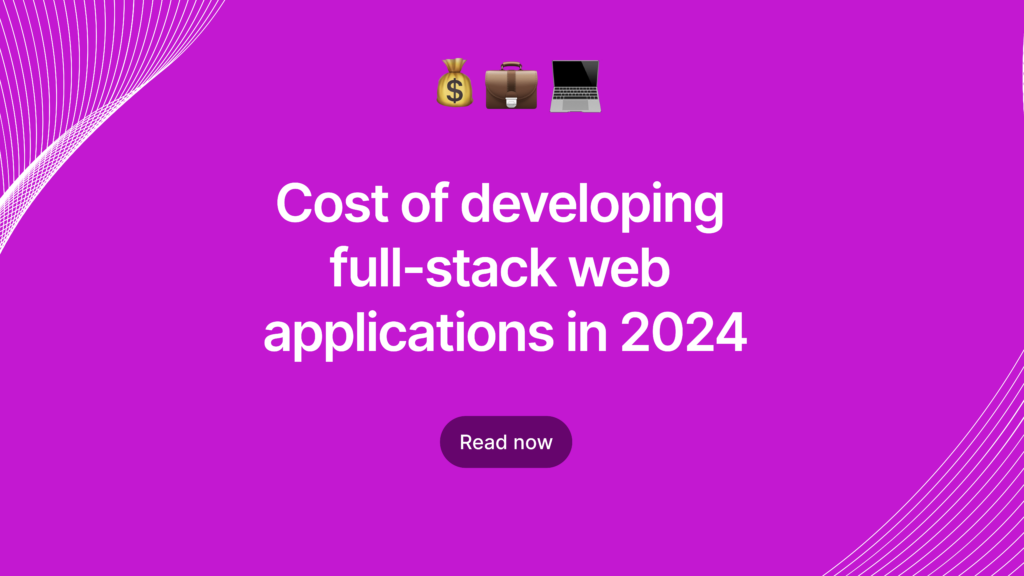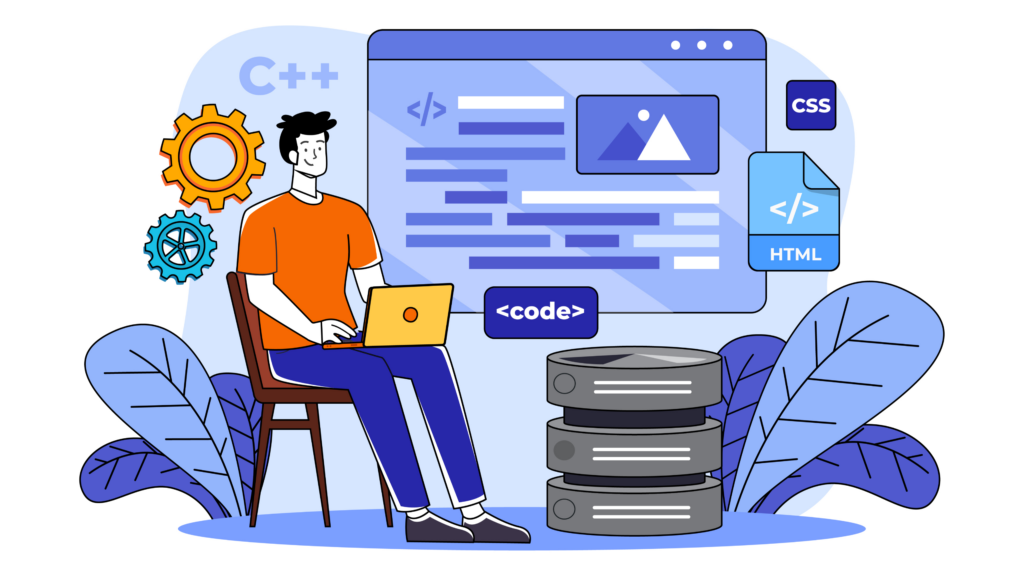
Web applications like Google Docs, Facebook, and Instagram have become typical playgrounds for most of us.
But they are not only websites but also complex web apps with diverse features to provide robust services to users.
According to PRNewswire, the web application market is expected to reach 10.149 billion USD by the end of 2027. All the stats and trends indicate one thing: if you are not living in cages, then it is the right time to move your business digital.
But wait? How will you do it, and how much will it cost? These questions must be arising in your mind.
There is no one-size-fits-all approach here because every web application is different, and multiple factors shape the overall development cost.
If you are looking for the cost of developing a full-stack web application, then you have landed at the right place, as we will dive deep into understanding the detailed pricing.
What is full stack development?
Imagine building a house. Full stack development is like being the person who designs the entire house and takes care of every aspect of making it functional and pretty.
In the web development world, “full stack” means being skilled in both the front end (what users see and interact with) and the back end (the behind-the-scenes server-side stuff). So, a full stack developer is like a one-person construction team for a website, handling everything from the layout and design users see to the databases and servers that store and manage the data behind it. It’s about having the skills to handle the entire process!
What can you do with full-stack development?
You can do a lot of stuff with full-stack development, starting from creating the look and feel that users interact with (like making it pretty and easy to use). You also handle the behind-the-scenes stuff – managing where all the information is stored, ensuring things work smoothly, and keeping everything safe from bad guys. It’s like being a chef who cooks delicious meals, designs the restaurant, manages the kitchen, and ensures everything runs perfectly. With full-stack development skills, you can build the whole website from start to finish, making it look good, work well, and stay secure.

Factors affecting the cost of full-stack development
As a founder, your web app idea is more than just a concept; it’s a potential venture. Understanding the factors influencing development costs is crucial for effective planning and execution. Let’s break it down in straightforward terms:
1. Complexity of the idea
Think of your web app as constructing a building. A simple app is like a cosy cottage, while a feature-rich gaming app is more like a modern mansion. Features like shopping carts, payment gateways, and social media integration add complexity, impacting costs.
2. Number of regulations
Industries like healthcare and fintech offer great opportunities but come with rules. Healthcare apps need FDA clearance, HIPAA compliance, and more. Fintech apps need to follow country-specific regulations like PSD and GDPR. Meeting these standards is crucial but can raise development costs. MedPortal, a healthcare solution, had to comply with HIPAA, affecting its overall cost.
3. Complexity of technical solution
Once you’ve assessed your idea’s complexity and regulatory needs, the technical complexity becomes clear. This influences the skill set needed in your development team. The more intricate the app, the more expertise is required, impacting costs. Think of it as hiring architects and builders for a skyscraper instead of a simple structure.
4. Prototype & design
Creating a blueprint for your app is like sketching a plan before building a house. The complexity of your app’s design and the need for detailed prototyping influence costs. Think of it as crafting the architectural design – a vital step impacting the overall project.
5. More than pretty colours
Visual appeal matters, but intricate features and user interfaces go beyond pretty colours. Advanced graphics, animations, and interactive elements add layers of complexity, affecting development costs. It’s like choosing between a simple paint job and a mural – each has cost implications.
6. User testing
User testing is crucial for your app, like test-driving a car before buying it. This step ensures that your app works seamlessly for its intended audience. Conducting thorough user testing adds time and resources but pays off in user satisfaction and a smoother app experience.
7. QA testing
Quality Assurance (QA) testing is like having a home inspector check every nook and cranny of your newly built house. It ensures your app functions flawlessly, identifying and fixing bugs or issues. QA testing is an investment in the reliability and performance of your app but adds to the overall development cost.
8: Maintenance & upkeep
Just as a house requires ongoing maintenance, your app needs regular updates and fixes. Technology evolves, and your app must keep up. Budgeting for post-launch maintenance is vital for long-term success. It’s akin to a homeowner’s responsibility to ensure the house stays in good shape over the years.
In summary, web app development costs go beyond the initial vision. Considering factors like design intricacy, user testing, QA, and post-launch maintenance is essential for a comprehensive understanding of the financial investment required.
App development: Outsourcing vs. In-House – Weighing the options
When developing a mobile app, businesses face a critical decision: should they outsource the development to external experts or build an in-house team? Let’s break down the pros and cons of both approaches:
Outsourcing app development
Pros
1. Cost efficiency: Outsourcing can be more cost-effective as it often involves lower labour costs, especially when leveraging talent from regions with a lower cost of living.
2. Access to global talent pool: Outsourcing allows access to a diverse and global talent pool, enabling businesses to choose from a wide range of skill sets and expertise.
3. Faster time-to-market: With an experienced external team, development timelines can be expedited, resulting in a quicker app launch.
4. Focus on core competencies: Outsourcing lets businesses concentrate on their core functions while leaving development tasks to specialists.
Cons
1. Communication challenges: Distance and time zone differences may lead to communication challenges. It requires effective collaboration tools and methods to bridge the gap.
2. Less control: The level of control over the development process may be reduced, and constant monitoring is necessary to ensure alignment with business goals.
3. Dependency on external providers: Relying on external vendors means a dependency on their schedules and potential challenges in scaling the team quickly.
In-House app development
Pros
1. Direct control: In-house teams provide direct control over the development process, allowing immediate adjustments and customization.
2. Team cohesion: An in-house team can foster a stronger sense of unity and shared goals, leading to better collaboration and communication.
3. Confidentiality and security: With sensitive projects, in-house development offers better data security and confidentiality control.
Cons:
1. Higher costs: In-house development can be more expensive due to higher labour costs, infrastructure expenses, and benefits for full-time employees.
2. Limited expertise: Depending solely on an in-house team may limit access to specific expertise and diverse skill sets compared to a global talent pool.
3. Longer time-to-market: Building an in-house team from scratch or hiring specific skills may elongate the time-to-market for the app.
In summary, the choice between outsourcing and in-house app development depends on factors like budget, project complexity, and the desired level of control. Outsourcing offers cost savings and access to a broader talent pool, while in-house development provides more control and a cohesive team. Careful consideration of these pros and cons is crucial for making an informed decision that aligns with the business’s goals and resources.

App development cost calculator
Ever wondered how much it costs to make your dream app? Well, wonder no more! Just tell it about your app plans, and bam! It gives you a clear idea of the money stuff. No more head-scratching. It helps you plan your app adventure money-wise, whether hiring help or doing it with your team. Easy-peasy, right? So, before making your app, check out our app development cost calculator.










